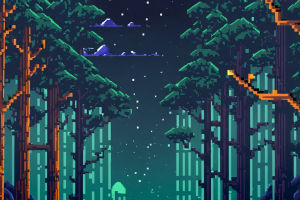Pixels to Powerhouse Art

Picture glowing dots dancing on a 1950s oscilloscope. This was gaming's first heartbeat, Lykkers! What began as scientific experiments became a global artistic movement.
Every frame today carries the DNA of pioneers who turned technical limitations into timeless expression. This journey through time showcases the artistry that has captivated audiences, from pixelated icons to breathtaking landscapes.
First Light
Physicist William Higinbotham ignited the spark in 1958 with Tennis for Two. Two lines and a bouncing dot captivated visitors at Brookhaven Lab. This humble proof-of-concept birthed an industry. Within decades, Atari and Nintendo transformed these electronic sketches into cultural phenomena.
Dot Matrix Era
The 1980s exploded with 8-bit charm. Space Invaders' marching aliens and Pac-Man's circular hero proved artistry thrived within grid constraints. Designers mastered tile-based graphics, packing personality into tiny squares. Limited palettes birthed iconic silhouettes recognized worldwide.
Palette Revolution
16-bit technology unleashed a color tsunami. Suddenly, 65,536 hues replaced mere hundreds. Characters gained emotional depth through subtle shading. Environments transformed from flat backdrops to layered worlds. Modern gems like Stardew Valley still harness this vibrant aesthetic.
Depth Dimension
The 3D graphics revolution reshaped reality. Early polygonal worlds in Battlezone felt like digital origami. Yet these angular landscapes birthed immersive adventures. Designers became architects, constructing spaces that players could physically navigate for the first time.
HD Realism
High Definition gaming made details visceral. Arotists rendered individual leaves in forests and scuffs on gear. Physically-based rendering simulated how light interacts with surfaces. This meticulous craft turned game worlds into living ecosystems that breathed beyond the screen.
World Weavers
Environmental designers emerged as visual storytellers. They transform lore into landscapes – a crumbling castle whispers history, while neon cities pulse with future dreams. Adobe notes these artists build "narrative spaces where every texture tells tales."
Tools Transformed
Early creators wrestled with cathode-ray tubes and light pens. Today's artists wield pressure-sensitive graphics tablets that capture brushstroke nuance. Wacom Cintiqs became digital canvases where imagination flows without technical friction.
Processing Power
Modern GPUs act as artistic enablers. NVIDIA RTX cards render complex scenes in real-time. This horsepower lets artists manipulate millions of polygons in software like Blender, creating details previously impossible.
Digital Atelier
The artist's toolbox now includes sculpting software like ZBrush (digital clay), open-source Blender (3D), and Adobe Substance (texture wizardry). Mastery of these tools separates hobbyists from industry-ready creators.
New Dimensions
Virtual Reality demands entirely new design rules. Artists craft 360° environments where every angle must enchant. Augmented Reality blends digital creatures with your living room, requiring seamless visual integration.
Style Spectrum
Today's games explode with visual diversity:
- Hyper-realism (The Last of Us)
- Cel-shaded fantasies (Zelda: Wind Waker)
- Minimalist dreamscapes (Journey)
- Geometric experiments (Monument Valley)
Iconic Birth
Shigeru Miyamoto sketched a carpenter with a red cap – birthing Mario. Link's green tunic became shorthand for adventure. These designs transcended screens, proving characters could embed themselves in global consciousness through pure visual language.
Skill Forge
Aspiring game artists need:
- Anatomy knowledge for believable creatures
- Color theory mastery for mood control
- 3D modeling precision
- Texture painting techniques
- Lighting expertise for cinematic impact
Creative Crucible
Formal training at schools like RMCAD provides structured pathways. Yet daily sketching, modding existing games, and studying film composition prove equally vital. The best artists remain eternal students.

Uncharted Canvas
From oscilloscope blips to photorealistic jungles, gaming's visual journey mirrors humanity's creative hunger. As AI tools emerge and cloud rendering evolves, one truth remains: technology enables, but human imagination ignites the magic. What worlds will you help build, Lykkers? The next frame awaits your brushstroke.
-
 Smart NPCs in GamingHow AI Enhances NPCs to Avoid Robotic Behavior and Become More Dynamic
Smart NPCs in GamingHow AI Enhances NPCs to Avoid Robotic Behavior and Become More Dynamic -
 Immersive VR GamingHow Virtual Reality Transforms Gaming Experiences and Immerses Players into New Worlds!
Immersive VR GamingHow Virtual Reality Transforms Gaming Experiences and Immerses Players into New Worlds! -
 Pixels to Powerhouse ArtFrom clunky pixels to breathtaking worlds—has gaming become today’s boldest art form? The transformation is jaw-dropping!
Pixels to Powerhouse ArtFrom clunky pixels to breathtaking worlds—has gaming become today’s boldest art form? The transformation is jaw-dropping!